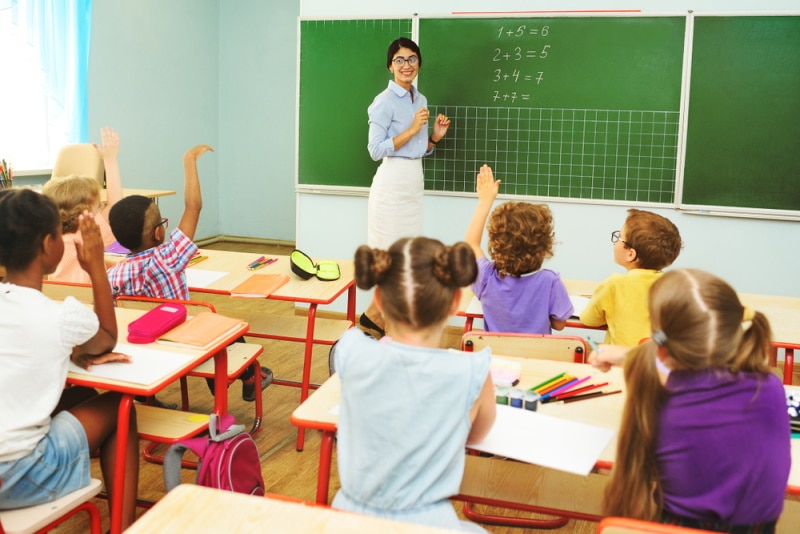What’s the Noise Level of a Typical Classroom? (Decibel Guide)
-

- Last updated:

If there is one place you need to keep a child’s undivided attention, it’s the classroom, and unfortunately, many schools today aren’t giving students the peace and quiet they need to learn.
According to the American National Standards Institute (ANSI), the sound of an empty classroom should be no more than 35 dBA, a sentiment shared with the World Health Organization. Yet study after study shows that schools aren’t providing that environment, instead offering spaces with background noise levels above 50 or even 60 decibels.
With schools failing to meet basic noise requirements, the classroom experience is a common frustration for teachers, students, and parents alike. Let us look at noise levels in a typical classroom and the implications for effective learning.
Decibel Standards for the Classroom
The ANSI voluntary standard S12.60, developed in 2002, recommends that an unoccupied classroom should have a maximum volume of 35 dBA. The A-rating considers our capacity for hearing various frequencies, giving us a more accurate understanding of a particular volume’s perceived loudness. For instance, low-frequency sounds must be at a higher decibel for us to hear, so they have less weight when measuring dBA.
Government agencies around the globe recognize the value of limited noise levels, with many setting unique standards for their classrooms. The 35-dBA baseline is reasonable for a standard 10,000-square-foot classroom, and some states, such as Connecticut, have adopted the ANSI S12.60 for their regulations.

How Loud Is a Typical Classroom?
| Decibel Level | Sounds Like… |
| 10 dB | Breathing |
| 20 dB | Ticking watch |
| 30 dB | Leaves rustling, whisper |
| 40 dB | Rainfall, running dishwasher |
| 50 dB | Empty classroom volume |
| 60 dB | Normal conversation, busy office |
| 70 dB | Car interior at 65 mph, vacuum cleaner |
| 80 dB | Lawnmower, heavy traffic |
| 90 dB | Hairdryer, subway train |
| 100 dB | Motorcycle, handheld drill |
A typical classroom is roughly 48 decibels when unoccupied. When a teacher is speaking or children are working in groups, the volume is generally around 60–70 decibels. Apart from the individuals in the room, numerous external and internal factors contribute to a classroom’s overall loudness. These noise sources can include:
- HVAC systems
- Plumbing
- Lighting
- Noise from adjacent rooms and hallways
- Playgrounds
- Road noise and overhead aircraft
- Rain and other weather
The school location and layout can make noise levels vary dramatically from one classroom to the next. Few school designs incorporate the ANSI standards, with some empty classrooms registering above 50 or 60 decibels due to loud air conditioners and external noise. As classrooms get louder, teachers and students are more susceptible to stress and fatigue, poor speech comprehension, and vocal strain as they must speak at higher volumes.

Noise and Learning
Noise and attention have an inverse relationship, a crucial consideration in several settings, from school to the workplace. As sounds increase around us, listening, concentrating, and focusing on work become more challenging, and we are less likely to accomplish our goals. Above 85 decibels, prolonged exposure can lead to gradual and permanent hearing loss, which is why OSHA requires hearing conservation programs for overly loud workplaces.
Several studies have shown a negative correlation between classroom noise and test scores. One study on second and fourth-grade classrooms in Iowa found students in louder rooms scored lower on reading comprehension tests, while a separate study revealed similar effects in classrooms across England and Wales.
Tolerable noise levels for a productive classroom are generally lower than in adult workplaces because children are more easily distracted and have underdeveloped speech perception. Hearing is a skill, with visual cues and acquired understanding allowing us to fill in gaps in conversation in a noisy environment. The ability to recognize speech against background noise continues to improve until late adolescence.

Signal-to-Noise Ratio in the Classroom
Since perception and recall suffer as volume increases, it’s crucial to cater to children’s needs to maximize comprehension and performance. The 35-dBA baseline works because it considers the signal-to-noise ratio (SNR) needed for a child to understand and pay attention to the lesson. The SNR is the difference between the decibel level of a particular signal or source (e.g., the teacher talking) and the decibel level of the background noise.
Children need an SNR 5–7 dB higher than adults to achieve a comparable speech comprehension level due to their impaired listening ability. According to the ANSI standard, an adequate SNR is +15 dBA, meaning a teacher would need to talk at 50 dBA in a 35 dBA classroom for successful communication.
A 50-dBA speech volume achieving a 15-dBA SNR hits the sweet spot for everyone in the classroom. As 60 decibels is roughly the volume of a typical conversation, the teacher won’t have to strain to overcome the ambient noise, and the children will not push their hearing past their tolerance threshold. While 85 decibels is the level at which noise-induced hearing loss can occur, many people consider volumes above 60 decibels to be either irritating or distracting.

Reverberation Time
Reverberation is when a sound lingers after the signal ceases, and reverberation time (RT) measures how quickly a sound decreases by 60 decibels. The size of the room and level of sound absorption determine reverberation, with larger spaces having longer RTs. For example, a hard-surfaced gym or auditorium will have a longer RT than a carpeted or sound-insulated classroom.
The ANSI standard for RT is 0.6 seconds in a classroom measuring 10,000 square feet. Longer reverberations and delayed reflections can cause issues with speech perception and subsequent attention. Alongside volume, the impact of RT is a vital consideration in constructing an optimal space.
Final Thoughts
Unfortunately, most schools across the globe miss the WHO’s 35-decibel mark in the classroom. Everyone needs a quieter space to integrate new information, and children have more obstacles hindering their comprehension, requiring even more consideration from the people designing their learning spaces.
Beyond adding simple sound dampeners in the room, teachers and community members have limited control over these aspects of the education experience. But with greater awareness and appreciation for the power of quiet workspaces, we can all make our voices heard to help children get the most from their time in the classroom.
Featured Image Credit: Ground Picture, Shutterstock
Contents

